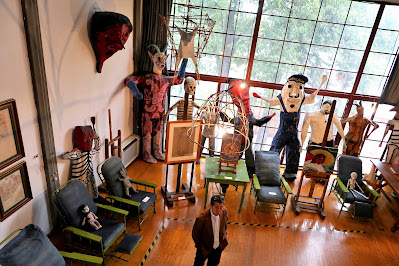My next two posts on my Blog will soon be on the Library at UNAM, University City and the Anajicalli, Diego Rivera's Museum. Both located in the southern part of Coyoacán and designed by Juan O'Gorman. So I thought I would first write a bit about O'Gorman.
He was born in 1905 in Mexico City to an Irish father Cecil Crawford O'Gorman, and Cecil's partner (and distant cousin) Encarnación O'Gorman. Juan O'Gorman's family had long divided their time between Mexico, Ireland, and England, and his father Cecil was a noted painter. His great grandfather had been the first British Consul to Mexico City in 1820.
Despite a cultured and privileged background, Juan O’Gorman’s path was to be a relatively unsteady one, full of reversals of fortune and surprising changes of direction.
Taking the artistic lead from his father, he decided to study architecture at the Academy of San Carlos in the National Autonomous University, where he discovered the work of Corbusier. At the age of 24, he had built his first house in the well-heeled, traditional neighborhood of San Ángel, for his father.
The house was brutally minimalist, in a style that he would champion for many years, using slab concrete, exposed wiring, and large window divided by smaller panes. Popular myth says the local response was that O’Gorman’s architecture degree should be revoked. The house is still standing and now available as an Airbnb rental.
Despite the local opinion of his work, his work was popular with his circle of influential friends, including Diego Rivera and Frida Kahlo, for whom he built two individual functionalist houses linked by a bridge.
These houses are now open to the public and have been preserved as they would have been when the couple lived there in the 1930s.It was during this decade that a wider interest in O’Gorman’s architectural style peaked and between 1932 and 1934, he worked for the Department of Education in Mexico, building 26 elementary schools under the principles the “engineer-architect” school of thought - maximizing functionality and minimizing cost.
However, despite the success of these schools, O’Gorman became dissatisfied with functionalism and began to move away from it towards organic architecture. He even denounced his previous association with the style, saying it had simply allowed the wealthy to create further profits by cutting building costs.
He began to paint murals influenced by the surrealist-modernist style of Rivera.
The most famous of these, Historia de
Michoacán (1941-42) in the Gertrudis Bocanegra Library in Patzcuaro,
deals with both pre-Columbian history and the colonization of Mexico.
It's a magnificent mural and one I enjoy re-visiting every time I am in
Patzcuaro. For more on the amazing mural, see my post dated 5/5/2010.
While living in the area, his second wife, Helen, a sculpture, took an interest in the pottery of the nearby village, Tzintzuntzan. At the time, the artisans were turning out crude bowls of soft, low fired clay decorated with painted Picasso type faces. She suggested they make plates, platters, cups and other pieces that would attract buyers. As a result, it was a big success locally and abroad. For years, the artisans would send her samples of their new designs as an expression of their gratitude.
Many of his murals were socialist and anti-fascist, which led to his murals in Mexico City’s first airport being removed in 1939 just two years after they had been completed.
At the end of the 1940s, Juan returned to architecture, building a house around a natural cave formation in Pedregal, covering it in mosaics which mixed Christian and Aztec symbolism - this was part of his and Diego Rivera’s project to create a vernacular Mexican architecture. Juan’s reputation as an eccentric character, paired with the fantastical nature of the house, brought busloads of tourists to his door.
For decades, Diego Rivera and his wife, Frida Kahlo, had planned to build a museum where the public could visit and contemplate their massive pre-Columbian collection. Unfortunately, Rivera’s dream never came to full fruition during his lifetime. When he died in 1957, his daughter Ruth collaborated with O’Gorman in order to fulfill the artist’s wishes. The Anahuacali Museo was built out of volcanic rock and was designed to symbolize a pyramid.
Despite his success, the Library soon began to look like the swan song of a man whose demeanor and health started to decline. In 1969, he sold his house to an architect who destroyed the mosaics and then demolished the house. Distancing himself from friends and family, his relationship with his second wife Helen broke down.
In 1982, after being diagnosed with a fatal heart condition, he took his own life.







No comments:
Post a Comment